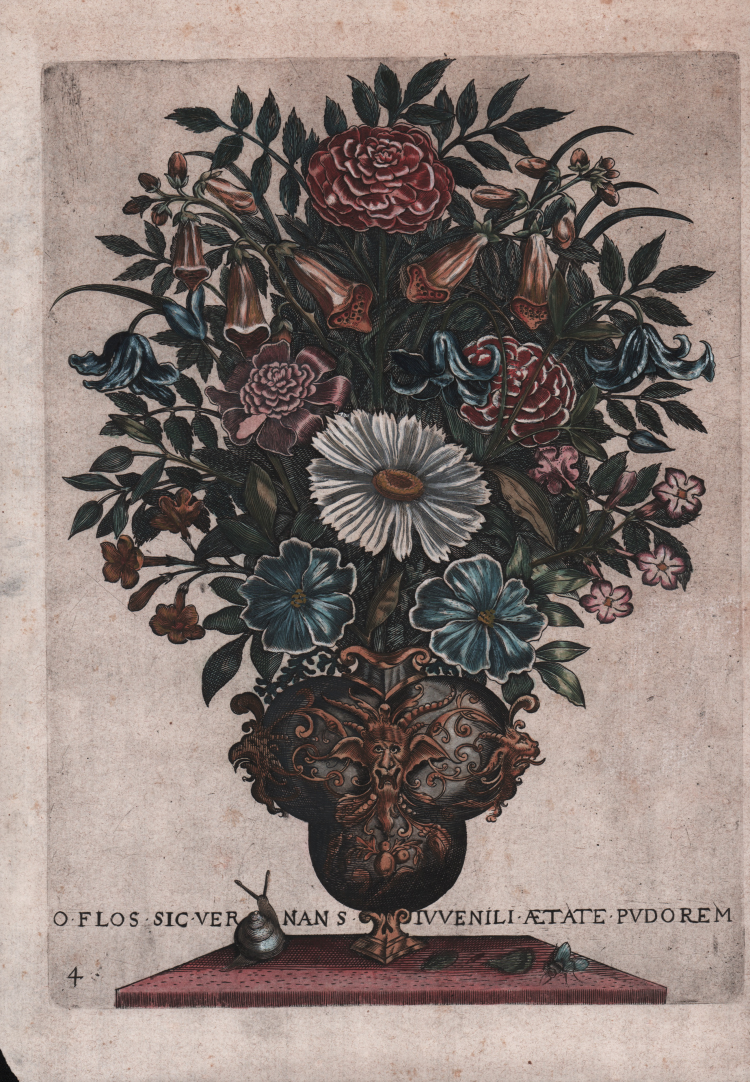



| Reference: | S29965 |
| Author | Filippo Succhielli |
| Year: | 1600 ca. |
| Measures: | 204 x 275 mm |


| Reference: | S29965 |
| Author | Filippo Succhielli |
| Year: | 1600 ca. |
| Measures: | 204 x 275 mm |
A vase with flowers on a table, with a fly and a snail, the vase decorated with the head of a demonic creature; copy in reverse after Johann-Theodor de Bry who engraved after Jacob Kempener.
Engraving, ca. 1600/1620, lacking signature and printing details.
The work belongs to the series Six Bouquets of Flowers in Vases. Numbered and signed in the lower corners: "4." Below the image, in a ribbon, Latin inscription: "O Flos sic Vernans Ivvenili ætate Pvdorem."
Although unsigned we believe this is one of the copies that the publisher Filippo Succhielli (publisher active between 1580 and 1620) published in Siena in the early 17th century. Counterpart copy of the engraving that Jan Sadeler published in Venice between 1597 and 1600
“This belongs to a set of six full-sized, reversed copies of Johann-Theodor de Bry's series of engravings after Jacob Kempener (Hollstein nos.451-56). The set will have been produced at some time between Jan Sadeler's arrival in Venice in 1596/7 and his death in 1600. When the Sadeler copies are compared with De Bry's originals it can be seen that a slight simplification has taken place and that they dispense with the ornamental borders which are a marked feature of the originals. Although in these copies the inscriptions are placed beneath the same vases of flowers as in De Bry's, the numerical order has been changed. Another set of copies was published by Jean Messager and Jean Picquet c.1620.
The role of the Sadelers who settled in Venice in 1596 or 1597 was an important one, for they brought into the city new approaches to printmaking and new genres of print. This series of flowers in vases had a very important role in introducing a new category of subject matter, and they were immediately very influential. Sets of copies bearing the addresses of Filippo Succhiello and Pietro Paolo Tozzi are an indication of that. The Tozzi series of 6 (300 x 230 mm approx.) one of them with address 'Pietro Paolo tozzi formis Padua' are rough and often perfunctory, with many mistakes in the transcriptions of the Latin inscriptions. A set of eight, including the six of Sadeler, was published by Succhielli in Siena (Cleri and Paoli, 1992, pp.74-81 and 139; in the inventory of the Urbania collection, p.139, the designs are said to be of Francesco Curti). There was also a set of reduced-size (192 x 145 mm) copies published by one of the Sadelers. These mix up the inscriptions, applying them to vases of flowers for which they were not originally intended (de Jong and de Groot, 1988, p.183, no.355); it should be noted that in the 29 May 1600 agreement between Jan and Raphael Sadeler there is a mention of a book of 13 plates with flowers.
There was in the North a tradition of paintings of flowers in vases, that can be traced back at least as far as the work of Ludger Tom Ring the Younger in Münster; one of his works is dated 1562. Theodore de Bry's prints after Kempener, which unfortunately are not dated, were innovative in introducing the subject into the graphic media. The ornamental borders of that original set indicate that they were conceived as prints to frame and hang on the wall. In all of them the flowers are arranged in such a way as to establish a strong degree of lateral symmetry: what Bergström called the 'radial composition' (Bergström, 1973, pp.22-26). The vases are very elaborate, each one being a separate invention, and fit with the tradition of series of prints of vases which starts with Agostino Veneziano (Bartsch XIV.387.541-552). The question arises whether the inscriptions are significant. They cleverly run through the declension of the word Flos, the Latin for flower. In the present set of copies, no. 5, with its inscription about the fugitiveness of the flower reminding us of our own ageing, has flowers that seem over-blown. On the other hand no.3, with its reference to the tenderness of youth being like the tenderness of flowers, has buds and flowers that are just opening, alongside opened ones. It is interesting that different kinds of meanings are attributed to the flowers, they are not just monotonously to remind us of our mortality. No.4, for example has an injunction to learn from the flower how to live decently (A FIORE ACCIPIAS HONESTE VIVERE DISCAS) which might be a reference to the Sermon on the Mount (Matthew 6, v.28)” (See text from Michael Bury, 'The Print in Italy 1550-1620' pp. 201-203).
A fine impression, printed on contemporary laid paper, with margins, in good condition. Example with fine original colouring with some retouches. Very rare.
Bibliografia
M. de Jong and I. de Groot, 'Ornamentprenten in het Rijksprentenkabinet I, 15de & 16de eeuw', Amsterdam 1988, no.355.A; Michael Bury, 'The Print in Italy 1550-1620', BM, London 2001, nos.147-148; Hollstein, Dutch and Flemish etchings, engravings and woodcuts c.1450-1700.
Filippo Succhielli(attivo a Siena 1580 - 1620)
Filippo Succhielli(attivo a Siena 1580 - 1620)